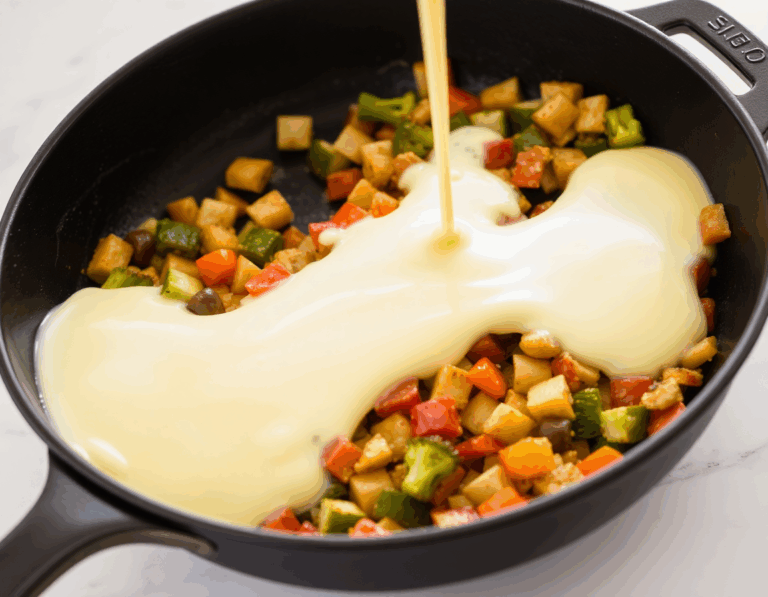
Spring is here, and with it, the promise of lighter, brighter meals that taste like sunshine on a plate. Frittatas, those versatile egg masterpieces, are my go-to when I’m craving something that’s both quick and endlessly adaptable—think garden-fresh veggies, a sprinkle of cheese, and whatever herbs you have languishing in the fridge. Did you know that some people even swear by adding a touch of leftover pasta? I tried it once, and let me tell you, it’s a revelation.
Steps
- Preheat your oven to 400°F (200°C). In a mixing bowl, whisk together eggs, almond milk (or your preferred milk), minced garlic, salt, and pepper until well combined.
- Heat olive oil in a 10 or 12-inch cast-iron skillet over medium heat. Sauté your chosen vegetables with a pinch of salt and pepper until they are tender.
- Stir in any herbs or spices, then pour the egg mixture over the sautéed veggies. Gently shake the skillet to evenly distribute the eggs among the vegetables.
- Sprinkle the top with cheese and transfer the skillet to the preheated oven. Bake for 15 to 20 minutes, or until the eggs are firm and the edges have a light golden color.
- Remove the skillet from the oven and let the frittata cool slightly. Slice into wedges and enjoy your meal!

Ingredients
- Eggs
- Almond milk (or any milk)
- Garlic, minced
- Salt
- Pepper
- 1 tablespoon olive oil
- Scallions
- Broccoli
- Smoked paprika
- Feta cheese, crumbled
- Salt
- Pepper
- ½ tablespoon olive oil
- 1 shallot, chopped
- 2 roasted red bell peppers, chopped
- 2 cups spinach
- Feta cheese, crumbled
- Salt
- Pepper
- ½ tablespoon olive oil
- Scallions
- Asparagus
- Peas
- Mozzarella cheese
- Feta cheese, crumbled
- Salt
- Pepper
- 1 tablespoon olive oil
- 1 shallot, chopped
- 12 ounces mixed mushrooms, chopped
- Tarragon, chopped
- Pecorino cheese, grated
- Salt
- Pepper
- ½ tablespoon olive oil
- 1 shallot, chopped
- Cherry tomatoes
- Basil, fresh
- Mozzarella cheese
- Salt
- Pepper
FAQ
- What is a frittata?
- A frittata is an egg-based dish similar to a crustless quiche. It is made by baking eggs with vegetables, herbs, and a touch of cheese, making it a versatile option for brunch or a quick dinner.
- How can I make a frittata?
- To create a frittata, start by whisking together eggs, milk, garlic, salt, and pepper. Sauté your chosen vegetables in a cast iron skillet, add herbs and spices, then pour in the egg mixture. Top with cheese and bake in a 400°F oven until the eggs set and the edges are golden.
- What are some popular frittata variations?
- Some delicious frittata variations include Broccoli & Feta, Roasted Red Pepper & Spinach, Spring Veggie with Asparagus, Mixed Mushroom & Tarragon, and Caprese with Cherry Tomatoes & Basil.
- What tips can help ensure a perfect frittata every time?
- Ensure your vegetables are evenly distributed in the pan before adding the eggs to avoid scrambling. Use a cast-iron skillet for even cooking and easy transfer from stovetop to oven. Be cautious, as the skillet handle will be hot after baking.
- What can I serve with a frittata?
- A frittata pairs well with brunch favorites like mimosas, French toast, or fruit salad. For a savory touch, garnish with fresh herbs or serve with avocado, lemony yogurt, or salsa. For dinner, a side of kale salad and crusty bread complements it nicely.
Tips
- Distribute your vegetables uniformly across the skillet before pouring in the egg mixture. This ensures that each bite has a consistent amount of veggies since you won’t be able to rearrange them much afterward without making scrambled eggs.
- Experiment with different combinations of herbs and vegetables. Remember to maintain a balanced ratio of 1/4 cup of vegetables per egg, or around 2 heaping cups of veggies for 6-8 eggs, for the best results.
- Opt for a cast-iron skillet when making a frittata. Cast iron skillets are perfect for transferring directly from the stovetop to the oven and provide even heat distribution. A well-seasoned skillet will also help prevent sticking, making serving and slicing easier.
- Be cautious with the hot skillet handle when removing it from the oven. Protect your hands by covering the handle with a kitchen towel or using a silicone handle cover until it cools down.
Equipment
- Cast Iron Skillet (10 or 12-inch)
- Silicone Handle Cover for Cast Iron Skillet
